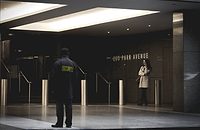To address rising crime levels as employees return to the office and business travel increases, organizations are revisiting their executive protection programs, corporate office security and emergency crisis response plans.
Most people believe executive security narrowly consists of executive protection agents and security drivers. While having the right personnel is of critical importance to the executive protection program, there are other equally important facets to a robust program.
Physical security threats to executives
Executive security must encompass all potential threats targeting business leadership. Security professionals can start by assessing the daily risk of the executives they protect, as well as their threat levels in travel situations.
Determining daily risk involves conducting a physical security evaluation and analysis of the defensibility, architecture, electronic security systems, infrastructure dependencies, operations, staffing, communications, and alarm monitoring and response elements of the overall security program at the principal’s residence(s), primary office and any corporate transportation hubs.
When assessing travel risk, security professionals should look into the risks specific to the principal’s mode and means of travel, including consideration for local and long-distance travel, drivers, executive protection details, flights, locations, storage of private aircraft, watercraft and/or motor vehicles, accommodations, communications and planning.
Protecting principals when they travel to publicized meetings or speaking engagements is considered a high risk scenario. An added layer of security staffing may be needed if any specific threats have been identified or based on the actual location where the public engagement is taking place. Assessing the scope and details of any speaking engagement or pre-announced event before it takes place is key, especially as many cities are now reporting increased levels of crime.
Corporate executives and those close to them also carry a risk of kidnapping by nefarious actors. Security professionals should evaluate the specific existing and future requirements for kidnap, ransom and extortion insurance for the principal.
Combatting online threats
Security professionals must get an accurate, real-time sense of the amount of information on executives is available for exploitation online.
As an example, a principal’s residence is a matter of public record, but finding the physical address no longer requires a visit to the county courthouse and flipping through deed records. Online databases collate this information in a central location, along with phone numbers, emails, vehicles, business affiliations and more. Reports can be obtained inexpensively, or in some cases are free, and available to anyone at any time.
Of great concern is that many online realtors contain images of the home from the last time it was placed on the market for sale. The furniture may have changed, but individuals can easily identify the presence of any security hardware, the internal layout of the home, and potential access points or locations where valuables may be stored. Principals with unsecured security cameras, such as baby monitors, may also have additional vulnerabilities, as one family found out when a hacker pretended to be Santa Claus when speaking to their daughter through a Ring camera.
The world has changed since before the COVID-19 pandemic and so have the types and levels of security threats. As executives return to the office, visit clients in and out of state, and conduct international business travel, a higher level of vigilance has become necessary. As we slowly enter the next phase of hybrid work and as corporate travel and speaking engagements return, the security of corporate executives should be a high priority.



